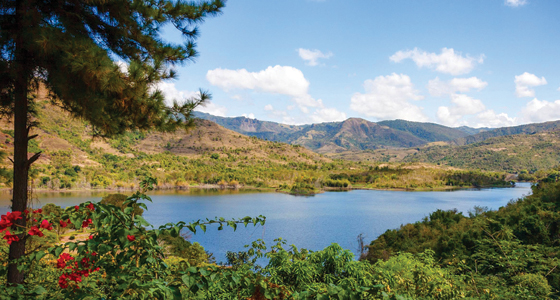A Green Innovation in Puerto Rico

There isn’t a lake in Puerto Rico that doesn’t sit behind a dam. Since 1913, this land of no natural lakes has been stopping up rivers to store water to generate electricity, irrigate crops and supply 65 percent of the population’s drinking water. Today, most of Puerto Rico’s man-made lakes face man-made problems.
According to data reported in 2010 to the U.S. Environmental Protection Agency by the Puerto Rico Environmental Quality Board, 17 of 18 reservoirs were falling short of Clean Water Act standards for dissolved oxygen needed to support aquatic life. The report listed pollution from agriculture and septic systems as common causes.
Thanks to a settlement between the U.S. Environmental Protection Agency and a water utility, a small water conservation company is engineering a man-made solution in an attempt at the island’s the first-ever lake restoration.
The restoration will target Lake Toa Vaca, a reservoir built originally to supply irrigation water to sugarcane crops on Puerto Rico’s southern coastal plain, which receives less rainfall than the rest of the island. But the plan changed when the dam was finished in 1972 and it became primarily a public water supply. As early as 1983, just 11 years after the 1,740-foot-long, 215-foot-tall Toa Vaca dam was finished, the reservoir had high levels of total nitrogen and total phosphorus, a harbinger of eutrophication.
In 2010, Toa Vaca was among the reservoirs failing to meet federal dissolved oxygen standards for supporting aquatic life. While the reservoir was meeting federal water quality standards for public drinking water sources, the local water treatment plant is only drawing water from its two shallowest intake pipes, according to Carlos González, CEO of Green Innovations Technologies, Inc., a water conservation company based in Puerto Rico.
Eutrophication has deprived the reservoir’s lower layer of dissolved oxygen, spurring a number of reactions that have fouled the water near the deeper intakes and made it too costly to treat.
González’s company has a chance to fix that. In 2010, the Puerto Rico Aqueduct and Sewer Authority agreed to pay $2.5 million to improve water quality on Toa Vaca as part of a settlement with the EPA over violations at 129 drinking water treatment plants. The sewer authority commissioned Green Innovations Technology to address the problems that come along with low dissolved oxygen, including a buildup of hydrogen sulfide generated by anaerobic bacteria.
 Hydrogen sulfide is toxic to fish, and its removal will be the first and most sensitive step towards restoration, González said. Green Innovations will install a series of ceramic diffusers on the lake bottom, a step required by the EPA settlement. Air pumped through the diffusers will create a plume of bubbles that will push tainted water from the bottom of the lake up to the surface where the gas can escape.
Hydrogen sulfide is toxic to fish, and its removal will be the first and most sensitive step towards restoration, González said. Green Innovations will install a series of ceramic diffusers on the lake bottom, a step required by the EPA settlement. Air pumped through the diffusers will create a plume of bubbles that will push tainted water from the bottom of the lake up to the surface where the gas can escape.
But it’s not a matter of blasting the gas out of the water as quickly as possible. While hydrogen sulfide is bad for aquatic life, it can also cause nausea, dizziness and headaches in people. And it reeks of rotten eggs. To keep human exposure to a safe level, a monitoring buoy floating in the lake will measure the emissions every five minutes and post the data online every 30 minutes. Those measurements will quickly let project staff know if they need to ease back on the bubblers and release the gas more slowly. If the measurements exceed 0.5 parts per million near the buoy, pumping will be reduced.
Once enough hydrogen sulfide has been released, the restoration will deal with the excess iron and manganese that resulted from the anaerobic conditions and affect the taste and smell of the water. They’ll also add beneficial bacteria and enzymes to speed up the process.
According to González, all of Puerto Rico’s reservoirs could benefit from similar treatment. Though new dams have been the answer to the commonwealth’s water problems since 1913, that will only work for so long. The island covers just 3,500 square miles, and its rivers have already been aggressively dammed. Large dam construction on Puerto Rico peaked in the 1950s, a decade before peaking in Europe and two decades before South America. This is the island’s first shot at lake restoration, and it could become an important strategy for protecting their current drinking water supplies.




0 comments